PR-0552UK Primary Science - Book 2
Create successful ePaper yourself
Turn your PDF publications into a flip-book with our unique Google optimized e-Paper software.
Sun facts<br />
Light ~ Activity 5<br />
Objectives<br />
• recognise that the sun gives us<br />
heat and light, without which we<br />
could not survive<br />
• become aware of the dangers of<br />
looking directly at the sun<br />
Working scientifically<br />
• Questioning<br />
• Predicting<br />
• Analysing (sorting and<br />
classifying)<br />
• Recording and communicating<br />
Designing and making<br />
• Exploring<br />
• Making<br />
Background information<br />
The sun is a star around which the<br />
Earth and all of the other planets<br />
in our solar system revolve. The<br />
energy that supports life on Earth<br />
is received from the sun. Humans<br />
have been relying on its heat and<br />
light for a million years. If the sun<br />
was to disappear, animals and plants<br />
would not be able to survive on the<br />
Earth. The rays of the sun bring a<br />
large amount of light to the Earth.<br />
This light is converted to heat energy<br />
within the Earth’s atmosphere, which<br />
holds much of the heat ‘in’.<br />
The sun is made up of 71% hydrogen,<br />
27% helium, and 2% of other, heavier<br />
elements. The temperature near the<br />
centre of the sun is about 16 000<br />
000 ºC.<br />
Half of all new cancers are skin<br />
cancers, caused by overexposure<br />
to the sun.<br />
The sun is an extremely intense<br />
source of light and should not be<br />
looked at directly with human eyes.<br />
Before the lesson<br />
Materials needed<br />
• No extra materials needed.<br />
Preparation<br />
• Draw a picture of a sun on the board or a chart.<br />
The lesson<br />
Stimulus<br />
• Brainstorm words with the pupils to describe the sun and write inside the<br />
picture you have drawn.<br />
• Explain that the word ‘solar’ means ‘having to do with the sun’; therefore ‘solar<br />
energy’ means energy from the sun.<br />
What to do<br />
• Write these headings on the board: ‘Sun Facts’, ‘Sun as our Friend’, ‘Sun as our<br />
Enemy’ and ‘Protection from the Sun’. Read each piece of information with the<br />
pupils and decide which heading it belongs under. Look at the key and colour<br />
the suns to match the heading.<br />
• Ask the class if anyone has accidentally looked at the sun before. What happens?<br />
Explain to the class that the sun is very powerful. If we look at it directly, even<br />
for a few seconds, the light entering the eye is concentrated to a point (as our<br />
eyes work like a magnifying glass) and it can burn the cells of our retina. The<br />
cells can be destroyed and that part of the retina can become blind.<br />
After the lesson<br />
Answers<br />
• Teacher check<br />
Additional activities<br />
• Pupils present the information as a project display. Use a large sheet of<br />
art paper to display on. Select only a set number of facts to describe.<br />
Specialise in ‘Facts’ or ‘Friend’ or ‘Enemy’.<br />
• Pupils make a poster warning of the dangers of the sun.<br />
– Looking directly at the sun.<br />
– Not protecting our skin from the sun’s rays.<br />
Viewing Sample<br />
Display ideas<br />
• In groups pupils make a ‘Sun Mobile’ with facts written on pieces of card and<br />
suspended on string and lengths of cane around the room.<br />
46 <strong>PR</strong>IMARY SCIENCE ~ Prim-Ed Publishing ~ www.prim-ed.com

















